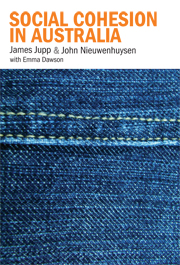Book contents
- Frontmatter
- Contents
- Foreword
- List of contributors
- List of tables
- Acknowledgments
- Introduction
- PART I DEFINING, MEASURING AND SEEKING SOCIAL COHESION
- 1 The quest for harmony
- 2 Conceptualising social cohesion
- 3 Measuring social cohesion in a diverse society
- 4 Australian government initiatives for social cohesion
- PART II THE DYNAMICS OF SOCIAL COHESION
- PART III INFLUENCES AND RESPONSES IN SEARCHING FOR SOCIAL COHESION
- References
- Index
1 - The quest for harmony
Published online by Cambridge University Press: 22 September 2009
- Frontmatter
- Contents
- Foreword
- List of contributors
- List of tables
- Acknowledgments
- Introduction
- PART I DEFINING, MEASURING AND SEEKING SOCIAL COHESION
- 1 The quest for harmony
- 2 Conceptualising social cohesion
- 3 Measuring social cohesion in a diverse society
- 4 Australian government initiatives for social cohesion
- PART II THE DYNAMICS OF SOCIAL COHESION
- PART III INFLUENCES AND RESPONSES IN SEARCHING FOR SOCIAL COHESION
- References
- Index
Summary
Australia is among the most cohesive and harmonious societies on earth, based on stable institutions, high living standards, economic expansion and isolation from zones of conflict. Since 1788 it has never had a revolution, never been invaded, and no public figure has been assassinated. Since 1860 it has regularly changed its governments through the ballot box. It extended the franchise to women well before Britain or the United States. Its industrial relations have been regulated by law for a century. Its police and politicians, though not perfect, are less corrupt than in many other developed societies. Its darkest shadow is cast by the failure to secure equality for its Indigenous minority, but that has also proved intractable elsewhere. Australia has no external colonies and relinquished its last possession, in Papua New Guinea, in 1975. It has developed a stronger sense of national identity than in the past, when many saw it as a British society.
Why then has there been so much anxiety expressed about social cohesion – now and in the past? Will this relatively benign condition continue? And what exceptions and problems remain? Since Sir Thomas More wrote Utopia in 1516, authors have been depicting ideal societies. But all are imaginary and none corresponds to the realities of a society like Australia. At the most elementary level a cohesive society is one that does not fall apart into what Geoffrey Blainey called ‘a nation of warring tribes’.
- Type
- Chapter
- Information
- Social Cohesion in Australia , pp. 9 - 20Publisher: Cambridge University PressPrint publication year: 2007
- 19
- Cited by



